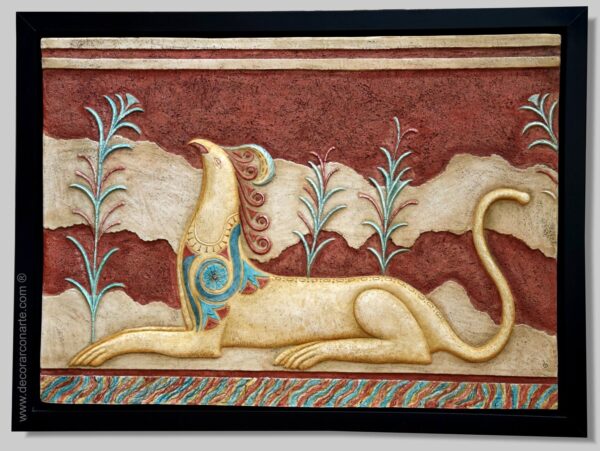Description
Mesopotamian Sphinx- Right. High-quality relief made of molded marble (marble powder bonded with resins). Aging finish achieved with patinas based on natural earth. With black wooden frame.
Total measurements of the relief with frame: Height: 62 cm. Width: 45 cm. Depth: 5 cm.
Measurements of the relief without frame: Height: 49.5 cm. Width: 33 cm.
Reproductions of sculptures and reliefs, inspired by original pieces from museums. Mesopotamian art. Handcrafted in Spain. Ideal for interior decoration (living rooms, lobbies, libraries, and offices).
Mesopotamian Sphinx- Right. Reproduction of a relief of the Winged Sphinx from the palace of Darius the Great (549-486 BCE) found in the city of Susa (present-day Iran). Reliefs inspired by glazed brick murals from the royal palace of Susa , 5th century BCE. Susa was the capital of the Elamite empire (1100 BCE-645 BCE). After its conquest by the Persians, it became one of the four major cities of the empire.
Mesopotamian sphinxes, called lamassu, are beings with human heads, wings, and bodies of bulls or lions. The lamassu in Mesopotamian mythology were celestial geniuses whose large statues were placed at the thresholds of palace gates for the protection of the premises. This type of winged lamassu sculptures were created in various Mesopotamian civilizations, from Assyria and Babylonia to the Persian Empire.
The Persian Empire was founded by King Cyrus the Great in the 6th century BCE, becoming one of the most influential civilizations of antiquity. Its vast territory stretched from the Mediterranean to the Indus, encompassing unprecedented ethnic and cultural diversity. The Achaemenids implemented a centralized government and efficient administration that facilitated the management of a vast empire. The Persian Empire was known for its religious and political tolerance, allowing conquered peoples to retain their traditions and religious practices. The victory of Alexander the Great in the 4th century BCE over the Persians marked the end of the Achaemenid dynasty, ushering in the Hellenistic rule of the Seleucid Empire until the conquest of Persia by the Parthian king Arsaces in the 3rd century BCE.


















Reviews
There are no reviews yet.